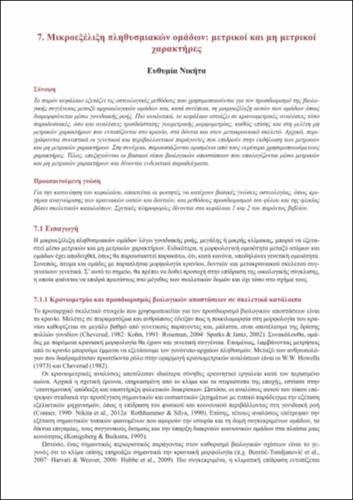| Title Details: | |
|
Microevolution of population groups: metric and non-metric characters |
|
| Authors: |
Nikita, Efthymia |
| Reviewer: |
Valakos, Efstratios |
| Subject: | MEDICINE AND HEALTH SCIENCES, LIFE SCIENCES, BIOLOGICAL SCIENCES > > MEDICINE AND HEALTH SCIENCES, LIFE SCIENCES, BIOLOGICAL SCIENCES > HEALTH SCIENCES MEDICINE AND HEALTH SCIENCES, LIFE SCIENCES, BIOLOGICAL SCIENCES > > > |
| Description: | |
| Abstract: |
Metric and non-metric skull traits can be used to evaluate the biological distance between populations. Skull morphology is influenced by both hereditary and non-genetic variables, including environment and nutrition. However, an abundance of studies indicates that there is genetic control over the shape of the skull that enables the use of craniometric analyses to infer biological links between populations. Driven by heredity, specific cranial and dental nonmetric traits (morphological changes in skeletal anatomy that cannot be measured) are also crucial for establishing biological links. This chapter provides the theoretical underpinnings of the pertinent techniques and students get acquainted with the procedures for recording metric and non-metric characters and their statistical analysis. Finally, there is a section with examples of applications of these techniques to ancient populations.
|
| Linguistic Editors: |
Athanasiadou, Kyriaki |
| Technical Editors: |
Afouxenidis, Afxentios |
| Graphic Editors: |
Afouxenidis, Afxentios |
| Type: |
Chapter |
| Creation Date: | 2015 |
| Item Details: | |
| License: |
Attribution – NonCommercial – NoDerivatives 4.0 International (CC BY-NC-ND 4.0) |
| Handle | http://hdl.handle.net/11419/4767 |
| Bibliographic Reference: | Nikita, E. (2015). Microevolution of population groups: metric and non-metric characters [Chapter]. In Papageorgopoulou, C., Moraitis, K., Nikita, E., Eliopoulos, C., & Vika, E. 2015. Specific topics in skeletal anthropology, taphonomy and bioarchaeology [Undergraduate textbook]. Kallipos, Open Academic Editions. https://hdl.handle.net/11419/4767 |
| Language: |
Greek |
| Is Part of: |
Specific topics in skeletal anthropology, taphonomy and bioarchaeology |
| Publication Origin: |
Kallipos, Open Academic Editions |

